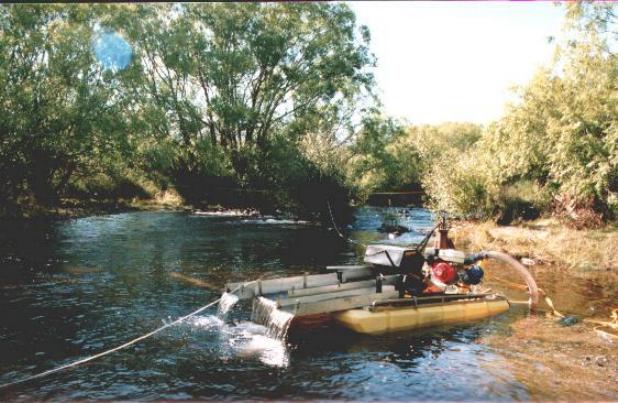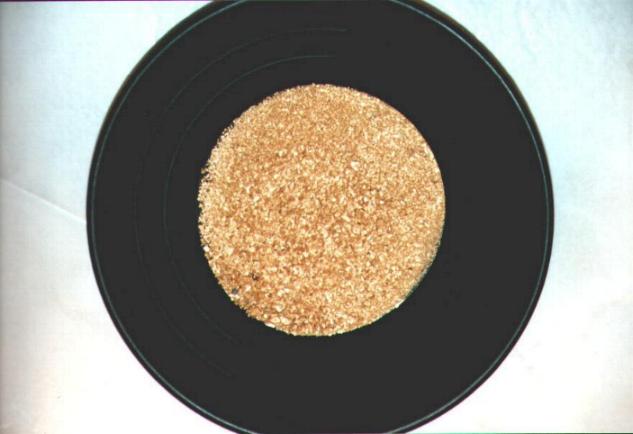|
|
|||||
 |
GOLD MINING |
||||
|
This I do in either of two ways--by metal detecting with a Minelab X-Terra 70 detector that I bought while on holiday in Australia, or by suction dredging with my 6" Keene dredge that I have imported from America. 
The 6" above is my latest aquisition having the new 3 in 1 table. This dredge is powered by two 9HP Honda motors driving two Keene 180 pumps - I was a bit worried when buying the dredge ex overseas without seeing one run. I talked in length with Mark Keene from Keene engineering and he really dispelled any fears that I might have had at the time. We discussed the motors/pumps and handling capabilities of the three in one table. I was all for going for the 11hp Hondas and 350 pumps. But in all reality it is only a 'mini' sized dredge for a 6" suction and as the table is not overly large (but proving to be more than adequate under most conditions,) he said that you have to be careful with the amount of water that you put down it. He then carefully explained to me how the floats were nearly 'maxed' out with the weight of the 9hp motors/pumps and the table was really designed around the 180 high pressure pumps. If they were to put the 350 pumps on to the motors the volume of water that they create would 'overwater' the table. I did at the start have a few problems trying to see how this could be - but - now it is as plain as day. A friend whom I dredge with has built a 6" with an over and under system - it has got twice the size table area that mine has - and needs it - he has it powered by two 13hp Hondas matched to 450 pumps. The amount of water that these 'beasties' create is enormous - yet the suction at nozzle end is much the same as mine - the difference being that Ians 450 set of pumps uses volume of water through 2" venturys to give suction in his jet tube whereas my 180 high pressure pumps create speed from ejected high pressure water through 1" venturys in my jet tube. I 'bit the bullet' and imported this dredge in June 2002. I do commend Mark for his time and his patience with me and the many worrisome emails from me with the vast amount of questions that I 'spammed' him with. I have done one small modification since owning the dredge - I found that if I was in a lot of river silt and fine sands and I am talking 'a lot', I found that the bottom slow flow table was silting up with the fines and blocking itself. The bottom table has a movable 'choke' to alow more water/sand flow but no matter where I put this or even when having the table on a fairly steep angle blocking still occured. The gap for the water/sands to go through was 25mm - so I just built another support frame for the upper sluice opening it out to 40mm and bingo it has solved all the inherent problems I was having. Even with the dredge running at full speed the finest of gold does not travel any more than a quarter of the length of the bottom table. 
I had a 5" Keene for nearly 20 years that had the older and still my favourite triple sluice table. It was powered by an 8hp Honda driving a Keene 350 pump. This dredge gave me stirling service over the years and caught me quite a reasonable amount of gold. The pic above is showing the 5" in a piece of river that I got the 4 ounces showing in the pan below. I managed to get this in 3 and a half days of dredging - just a little 'hotspot' of flood gold that has been laid over the years during flooding by the river. - 
Gold dredging/panning/ gold fields touring holiday packages In the southern part of the South island of New Zealand is an area called 'Central Otago'. Within this area is a township called 'Naseby'and this is where My wife and I have made our present home. The house is set out on to two acres of lawns and gardens and the backdrop is the Naseby forest which was started after the mining finished in the area.
Here in Naseby we are surrounded by a lot of New zealands mining history. Quite a few of the local rivers have gold in them, as is evident from when you start by taking 2 or 3 pans of gravels from them. The old miners were pretty thorough and did not leave too much for those coming behind so this prompted me in to making my first dredge, as I found that to work with a shovel into a pan or hand sluice was quite hard work - and slow. I made the decision to build my first dredge and finding this a good way to do my mining stepped up to the Keene 5" Triple to be able to work under water and then recently updated again to a 6" model Keene twin 9hp 6" dredge.
I had decided to retire from my nearly 40 years of commercial fishing and along with wife start gold mining/dredging/touring holidays here, for interested miners from within New Zealand and from abroad that do during their winter start suffering from the old 'cabin fever syndrom'.
For $US150 a day we will pick up/drop off from our airport - supply a gold dredge to work or buddy work with me on the one dredge -then - If the rivers are affected by rain and they cannot be worked successfully - a bit of 4WD touring around our gold fields or tourist spots, of which there are plenty, would be in order. If you have a detector that you might like to bring with you there is always the old piles of tailings close at hand.
After a "hard' day in the river we invite you to join us in a bit of Kiwi hospitality in the way of some music - wine or the old favourite local 'Speights' beer, followed by some of our 'gastronomic delights' conjured up on the barby. Accommodation is with us in our house and we will go out way to ensure that your stay is both memorable and enjoyable. To make contact with Denise or Allan
EMail
us here
MAKING YOUR OWN DREDGE The dredge that is featured below is a 5" suction nozzle, motor on the bank type, that I made a few years back, it is powered by a five horse power Honda motor and a treasure emporium pump. I felt that the suction was not the greatest and added another motor in series which really increased its ability to handle any amount that you could stick up the nozzle. The table was six foot long and of step ladder construction- it had a small 6" - 8" flare at the start and widened out to 24" at the end. The effect on the water flow was one of slowing down as it progressed along the table towards the wider end, and this in turn really let any fine gold settle well before it had moved very far down the table. I used hungarian riffles and found these to be very effective when working in areas of flood gold. For ease of portability I floated the table on two car tubes, the front one being 16" and the rear one 12". The stability of the whole unit was quite amazing even in areas of faster flowing water. The nozzle I made out of light 5" steam pipe and had a 7/8" ventury. The lift pipe which widened out to 6" behind the nozzle was six foot long and made out of aluminium, as was the rest of the box. I share my dredging time with one or two friends whenever time and weather permit. The areas
that I mine in are in the 'Central Otago' gold fields, mainly close by to Naseby, where we have bought ourselves a lovely home. A very useful sight when looking for things to do and for great scenic places to visit while holidaying here is Adventure
New Zealand
'Gold Day' in the 'Hogburn creek'... Xmas gold rush day - watch out for the flying stones and kids!! The unit in use here is my old 'home made' 5" step ladder table - suction nozzle dredge
PICTURES OF MINING.
Who needs friends when they try to drown you(picture)
Taken at 150yrs / cavalcade celebrations Cromwell, Central Otago."Hey Gramps, move your foot so I can get mine on it to"!! (picture)
Ians 6" and my 6" doing a bit of buddy dredging (picture)
Another pic of Ians and my 6" dredges doing a bit of buddy dredging
Taken at 150yrs / cavalcade celebrations Cromwell, Central Otago.'Gramps and Jess (grand-daughter) (picture)
Suction dredging for gold on my claim on the Little kyeburn River I am using my 'Keene triple sluice' imported from U.S.A.(picture)
Another shot of me dredging in the little Kyeburn river(picture)
Pic of some of the rewards for a bit of hard grafting under water(picture)
Another shot of the goodies in the pan(picture)
Who is this masked man??(picture)
Transport over the river to a mine. This river was dredged by the old bucket systems in the 1870's. It proved to be a very rich river and still has a lot of pockets of gold left untouched(picture)
This dredge I made up from a picture out of a book. After I did a few modifications it proved to be a really good gold saving unit(picture)
Keene 5" dredge 1(picture)
Keene 5" dredge 3(picture)
Keene 5" dredge 4(picture)
I suppose I should look happy but is enough really enough?(picture)
|
|||||
|
|
|||||
